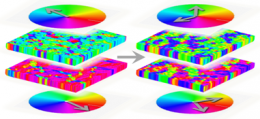Spin polarized supercurrents optimized with a simple flip

(Phys.org) -- Researchers from Michigan State University, the NIST Center for Neutron Research, and the NIST Center for Nanoscale Science and Technology have discovered the key to controlling and enhancing the lossless flow of a current with a single electron spin state in a standard superconducting device.
Production of superconducting currents ("supercurrents") that are also spin polarized opens up new possibilities in spintronics, an emerging field that integrates magnetic phenomena into conventional semiconductor electronics. The Michigan State researchers previously demonstrated that a spin-polarized supercurrent can be generated and sustained over a long range by passing a current through a carefully engineered stack of superconducting and magnetic thin films. However, they were surprised to discover that a substantially larger current can be created by exposing the device to a magnetic field.
The mystery was solved by NIST scientists who determined the complex magnetic configuration of the layers in the stack using the complementary techniques of Polarized Neutron Reflectivity (PNR) and Scanning Electron Microscopy with Polarization Analysis (SEMPA). Together these measurements revealed that the magnetic field flips most of the magnetic layers to create a more ideal local environment for sustaining the polarized current.
The researchers believe that combining spin polarized supercurrents and spintronics, such as spin transistors and spin filters, will eventually lead to novel applications similar to ones generated when superconducting devices were first combined with electronics.
More information: Optimization of spin-triplet supercurrent in ferromagnetic Josephson junctions, C. Klose, et al., Physical Review Letters 108, 127002 (2012).
Provided by National Institute of Standards and Technology

















